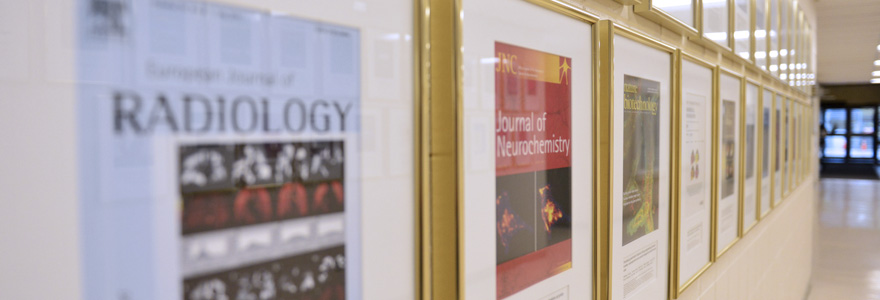Under the Covers
Framed journal covers don the walls at Robarts Research Institute, forming a mosaic of scientific excellence that tells the story of the Institute’s history, its people and the medical discovery taking place in its labs each and every day
By Ramtin Hakimjavadi, BMSc Candidate
Upon entering Robarts Research Institute, one finds a plaque that reads “Celebrating the accomplishments of Robarts scientists whose research made the cover.” Surrounding it, there are rows of framed journal covers with beautiful images – publications being featured by various scientific journals.
These hallways inspire awe, these walls are historic, and these journal covers represent more than just the accomplishments of individual Robarts scientists.
To ‘make the cover’ of a scientific journal is a tremendous achievement. “Having an illustration related to your publication is a symbol of the recognition of the journal for the importance of your work. It’s not just a pretty picture,” explained Gregory Dekaban, PhD, who was one of the founding scientists at Robarts and serves as Acting Chair, Microbiology and Immunology.
 The framing of the journal covers is a long-standing tradition at Robarts. The Institute dedicates space on the wall to acknowledge the milestone achieved by their own. “We will continue this tradition and recognize the accomplishments of our scientists,” said Dekaban.
The framing of the journal covers is a long-standing tradition at Robarts. The Institute dedicates space on the wall to acknowledge the milestone achieved by their own. “We will continue this tradition and recognize the accomplishments of our scientists,” said Dekaban.
The inaugural journal cover placed on the wall belongs to world-renowned neurologist and founding director of the Institute Dr. Henry Barnett. Internationally recognized for his investigative medical research, Dr. Barnett led a series of clinical trials showing that Aspirin is an effective preventative therapy for heart attack and stroke.
“This journal cover belongs to the initial publication that put Robarts on the map. This is what brought the Institute international acclaim,” said Dekaban.
The momentum generated by Dr. Barnett’s landmark publications has carried forward through the proceeding decades. Since 1986, distinguished Robarts scientists have continued to populate the walls with new journal covers – scientific excellence being transferred from one generation to the next.
The journal covers serve to tell a story – a tale of how Robarts has evolved to establish a lineage of important biological, medical and imaging research. On the walls, there are stories of fruitful multidisciplinary collaborations, successful student-mentor relationships, and breakthroughs accelerated by leveraging cutting-edge technology.
Miranda Kirby, PhD’13, is a rising star in medical imaging and a former Robarts trainee. As a recipient of multiple journal covers, she can truly attest to the Institute’s unique environment. “I believe the culture of collaboration at Robarts helped me see the value of interdisciplinary research and become a more collaborative scientist.”
Kirby, who was supervised by Grace Parraga, PhD, had the opportunity to work alongside students trained in physics, biomedical engineering, biochemistry, health sciences and computer science. This diversity helped her tremendously in producing multiple highly acclaimed publications that made the cover. “Drawing on our collective strengths, experiences and perspectives leads to novel questions and solutions,” she said.
Today, she continues her research in medical imaging as a Tier 2 Canada Research Chair in Qualitative Imaging at Ryerson University. Back at the Institute, she leaves a trail of journal covers that capture the significance of her contributions. “These journal covers represent a snapshot in time when we were demonstrating the potential of new [imaging] technology. They represent the novelty and excitement of the research at the time.”
William Monty McKillop, BMSc’05, MSc’08, PhD’14, began his journey at Robarts as an undergraduate biochemistry student, initially under the supervision and mentorship of Dekaban. For his research examining the biochemical parameters and intracellular localization of the CD11d protein, McKillop’s publication reached the cover for the Journal of Leukocyte Biology.
As a former trainee, McKillop truly values the mentorship he received at the Institute. “Greg sets up an environment where it is easy to learn from people that are eager to teach,” he described.
Under the tutelage of Phillipe-Alexandre Gilbert, a postdoctoral fellow in the Dekaban Lab at the time, he recalls being very well-trained. “I really understood what I was doing and why I was doing it. That provided a wonderful environment for me to learn and grow as a scientist,” he said.
Each publication lists only the contributing authors, but behind each journal cover there is a strong community of Robarts scientists supporting their own. McKillop highlights some of the important work done by his fellow scientists during his time at Robarts. “Some landmark papers never made it to the wall,” he said. “Mine did, but in many ways it should serve as a testament to the work completed by researchers in the Weaver-Brown-Dekaban Labs around this study. They all deserve recognition for their hard work.
McKillop’s journal cover image was taken using confocal microscopy. “Although it has only been 10 years, that work was very ground-breaking for its time,” said McKillop. “Back then, it was cutting-edge equipment and not many people had access to it.” Therefore, the beautiful images on these covers are not artificially contrived simply to catch the eye. They are figures taken from real data in the research – each cover a symbol of the Institute’s continued investment into the most advanced technology available.
Fabiana Crowley, PhD, started her research at Robarts as a PhD trainee with Marco Prado, PhD. She achieved a journal cover for her work examining how amyloid-beta peptide interacts with prion protein (PrP(C)) to increase localization at the cell surface – a mechanism with important implications for Alzheimer’s disease research. Later, Crowley began to work with Stephen Ferguson, PhD, as a research associate and core facilities manager for the imaging facility.
Crowley’s journal cover is yet another story of advanced technology paired with phenomenal science. “What impresses me is the amount of resources we had there, from the equipment to the expertise,” she said.
Taking advantage of total internal reflection fluorescence (TIRF) microscopy – a technique that is considered high-end even today – Crowley received her cover for the Journal of Neurochemistry.
The journeys of Kirby, McKillop and Crowley in achieving their journal covers embody what has come to define Robarts throughout its history. The training culture pairs young, curious scientists with experienced mentors, creating relationships that maintain a standard of high-quality research from one generation to the next. The underlying infrastructure at Robarts, and the continued investment into advanced scientific instruments, allow for deeper scientific inquiry. The environment encourages collaboration, producing multidisciplinary research whose whole is greater than the sum of its parts.
No matter the career path subsequently taken by these former trainees, there remains tremendous meaning in having a space on the wall dedicated to their names. “To be associated with such a high level of science is phenomenally rewarding,” said McKillop.
Kirby agrees. “The quality of the research that is generated by Robarts scientists is exceptional, and I am honoured to have my research featured among them.”
Each cover represents a snapshot of time in the Institute’s history, capturing the vision that has allowed Robarts to accelerate medical discovery. Collectively, the journal covers on the Robarts walls form a mosaic of scientific excellence. Thirty-three years since its establishment, the Institute maintains its status as a leader in the basic and clinical research domain – and so continues the framing of journal covers.









